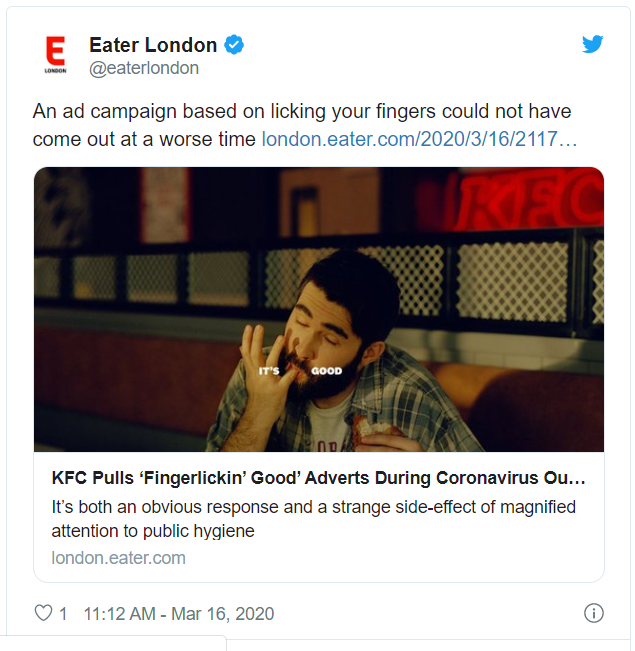Even in the search industry, which prides itself on agility and adaptability, the escalating menace of the novel coronavirus pandemic is something very different.
Collectively, we are pretty adept at devising new strategies and tactics when Google rolls out a major algorithmic update.
So, we are fairly well prepared to respond quickly and effectively to the coronavirus pandemic – as long as we recognize that COVID-19 isn’t an algorithm change.
In fact, it is already having a bigger impact on user intent and behavior because the combination of a global pandemic and worldwide recession is changing our organic search results more than the Panda and Penguin updates did put together.
And, while many of our colleagues in digital marketing are bunkered up and hunkered down during this double-barreled threat, this particular crisis represents a unique opportunity for SEOs to help craft their company’s or clients’ coronavirus response.
If we’re bold enough to seize it.
For example, it takes courage to conduct a new round of keyword research and propose creating a new FAQ page that answers questions that people are now asking, such as:
- Will coronavirus cause a recession?
- Will coronavirus affect the housing market?
- Can coronavirus live on clothes?
- Can coronavirus be transmitted through food?
- When will coronavirus pandemic end?
- How will coronavirus change the world?
- How will COVID-19 affect the economy?
Why is this fraught with risk?
Because your company or clients may not have answered these questions.
And, you will need to be brave to urge your colleagues in content marketing to create and optimize several new blog posts that tackle a new set of topics that aren’t in the editorial calendar that was created in late 2019.
Why?
Because it’s easier to stick to the plan.
But, step back a moment and you’ll see that these steps would have been a great response in the era of “10 blue links.” That era officially ended in May 2007.
And, if your response plan in 2020 doesn’t include creating and optimizing a series of new YouTube videos, then you’re still fighting the last war.
That’s why this crisis represents a significant opportunity for the 500,000 out of the 3 million SEOs in the world, who already mention “video SEO” in their LinkedIn profile.
They already have the digital marketing skills, education, and experience to help companies craft coronavirus response videos.
And, for the other 83% of SEOs who need a quick cheat sheet on the latest best practices for optimizing videos, I recommend reading: “YouTube Algorithm: 7 Key Findings You Must Know.”
And, if you have trouble getting a seat at the table – especially at a time when many digital marketing teams are working remotely or trying to increase their social distance – then share a link to this article: “YouTube’s Organic Visibility Tops Wikipedia in Google SERPs.”
Once you have a seat at the table, you’ll be expected to deliver strategic insights, critical data, and tactical advice.
Now, I’m going to share some ideas below that should help you come up with your own plans, which should be tailored to your market.
Why?
Because there is no one-size-fits-all solution.
1. Do No Harm
The first thing that you’ll want to do is get up to speed on what the World Health Organization (WHO) is recommending.
WHO’s primary role is to direct international health within the United Nations’ system and to lead partners in global health responses.
You’ll find that WHO’s YouTube channel is uploading their daily press briefings on COVID-19 to their and uploading explainer videos like “How to protect yourself against COVID-19.”
If your company or clients are located in the United States, then check out the advice from the Centers for Disease Control and Prevention (CDC).
The CDC’s YouTube channel is also uploading a series of explainer videos and reaching out to the private sector, public health organizations, universities, and clinical societies with videos like “CDC Private Sector Partner Call for COVID-19 – March 19, 2020.”
Now, why should you spend time watching WHO’s and CDC’s videos?
Well, you need to recognize that you need a different approach to conducting keyword research in a crisis that is growing exponentially.
Google has long acknowledged that 15% of the queries conducted by users on a daily basis have never been seen before.
But few SEOs have stopped to ask, “Where do these brand new phrases come from?”
Well, the stork doesn’t deliver these baby keywords overnight.
If you’re looking for the putative father of new search terms, then you don’t need to be Sherlock Holmes to logically deduct from the available clues that it’s the “news.”
And watching WHO’s and the CDC’s videos will also enable you to avoid making the kind of mistakes that KFC U.K. made last week.
Now, to be fair, KFC coined its catchphrase “Finger lickin’ good” more than 60 years ago.
But, it was still a bad idea to launch an ad campaign in Great Britain showing a montage of people eating KFC’s fried chicken and sensuously licking their fingers, while Chopin’s Nocturne Opus 9 No.2 played in the background.
I can’t share the video with you here because KFC U.K. pulled the campaign after Eater London observed:
“An ad campaign based on licking your fingers could not have come out at a worse time.”

And, in order to ensure that you don’t become “that guy,” then you need to keep up with the latest news about social distancing, hand-washing, and restaurant closures as well as recent keyword trends.
For example, check out “McDelivery – Family Night – Board Games,” which was uploaded back on March 13.
As the video’s description says, “With McDelivery, the fun never stops.”
Kudos to McDonald’s Canada for being ahead of the curve on responding to rapidly changing trends.
2. Make a ‘Talking Head’ Video
Your next step is to propose shooting a video of a “talking head” addressing the camera.
This is the bare minimum that your company or clients should do to respond to the crisis.
Now, the choice of which “talking head” to put in front of the camera is up to you.
As an SEO, you already understand the importance of E-A-T (Expertise, Authoritativeness, and Trustworthiness). So, it doesn’t have to be your CEO, although that is one of the most likely candidates.
For example, JetBlue’s President and Chief Operating Officer is featured in “Joanna Geraghty on JetBlue’s coronavirus response.”
Obviously, the airline’s President and COO is an “authority” on the company’s response to the pandemic.
But, Dr. Russell Brown, the Quantas Group Medical Officer, and Darsh Chapman, the head of Australian Regional Operations and Airport Services, are featured in “Coronavirus Update 12 March 2020 – Qantas Medical and Cleaning.”
Obviously, the airline selected its “experts” to speak on these topics.
Want an example of a “trustworthy” person to put in front of the camera.
Then, watch “The next outbreak? We’re not ready | Bill Gates.”
Why should you trust the “talking head” is this TED Talk?
Because Bill Gates shared these “ideas worth spreading” almost five years ago in April 2015.
3. Use Video to Show & Tell
Next, look around and find someone who is comfortable enough on camera to be able to show and tell important information without needing a teleprompter.
For example, Gordon Ramsay is a British chef, restaurateur, writer, television personality and food critic.
He uploads recipe tutorials, tips, and techniques to his YouTube channel every week.
So, when “Gordon Ramsay Shows You The Proper Way to Wash Your hands in the Kitchen,” you can see immediately that he is an expert and an authority that viewers can trust.
And, as the description under this video says:
“Hygiene is so important right now with the CoronaVirus (that) Gordon is showing you the right way to wash your hands. Be safe out there and we’ll get through this together.”
Now, you aren’t limited to using a single person on camera.
For example, watch “How To Make Your Own Hand Sanitizer | Dr. Ian Smith” on the Rachael Ray Show channel.
As the video’s description notes, “Coronavirus (COVID-19) has people so worried about getting sick that hand sanitizer is selling out. Here’s how to make your own hand sanitizer if needed.”
Or, check out “DIY Mask for Coronavirus – Innovative Solutions to PPE Shortage at Henry Ford Allegiance Health.” As the video’s description says:
“Given a scarcity of personal protective equipment (PPE) for health care workers and first responders, Henry Ford Allegiance Health has taken an innovative approach to creating their own, using safe and comfortable materials that will protect caregivers from the COVID-19 virus. With the support of Henry Ford Innovation Institute and local manufacturers, we hope to replicate these models across the entire Henry Ford Health System.”
4. Create ‘Help’ Content
Next, borrow a page from the YouTube creator playbook for brands and create “help” content.
What’s that?
Well, instead of optimizing your existing YouTube videos, it makes more sense to start making new videos that quickly and clearly answer relevant queries.
If your brand can credibly answer some of these queries, then and only then create a series of “help” videos that are optimized for those search terms.
Which brand is doing the best job at creating help content on the coronavirus?
Based on my research over the past few days, it is the Boots UK channel on YouTube.
A health and beauty retailer as well as a pharmacy chain in the United Kingdom and other countries,
Boots uploaded 14 videos that answered questions about coronavirus in five days.
Boots uploaded six “help” videos on Monday, March 16, including: “16/03/2020 Coronavirus advice | Can antibiotics kill the virus? | Boots Pharmacy.”
Boots uploaded another six “help” videos on Wednesday, March 18, including: “18/03/2020 Coronavirus advice | What should I do if I start to develop symptoms? | Boots Pharmacy.”
And Boots uploaded two more videos on Friday, March 20, including: “20/03/2020 Are your pharmacists still working?”
If you need to show decision-makers on this side of the pond some examples of “help” content, then show them this exemplary series of videos from Boots UK.
5. Create ‘Hub’ Content
According to the YouTube Creator Playbook for Brands, “Hub” content is regular, scheduled content that provides a reason to subscribe to a channel and return on a regular basis.
For example, the new YouTube Creators Channel, formerly known as The Creator Academy, publishes new content each week, including education and inspiration from YouTube experts, and fellow creators.
That enables it to address new and trending topics like the latest on changes at YouTube related to COVID-19 as soon as the next episode is created.
Just watch “Coronavirus and YouTube: Answering Creator Questions” to get the latest information from Matt Koval, YouTube’s Creator Liaison.
And when you’re done watching this six-minute long video, check out the description below. It uses best practices for helping viewers jump to specific questions.
Another example of “hub” content that has addressed how coronavirus is impacting everything on the planet, including YouTube, comes from the vidIQ channel.
More than a week ago, Rob Wilson, vidIQ’s YouTuber-in-residence, uploaded “Coronavirus and its Impact on YouTube and Creators.”
At the same time, he published “Coronavirus: The Impact on YouTube and YouTubers” on vidIQ’s blog.
And pay attention not only to his practical advice below, but also note how he asks viewers to make comments, which is another best practice.
6. Create ‘Hero’ Content
According to the YouTube Creator Playbook for Brands, “hero” content refers to the big, tent-pole events that are designed to provide a massive step-change to your audience growth.
Hero content could be a live-streamed event, a viral video, a cross-promotion with a YouTube influencer, or even a made-for-YouTube ad.
It may revolve around a large cultural event like Halloween or the Super Bowl, or it may be a major event that you instigate.
And, during the novel coronavirus pandemic, we need to create all the “hero” content that brands and their agencies can muster. But, SEOs need to be part of the team crafting coronavirus response videos.
Why? You may have already read, “Is a Super Bowl Ad the Equivalent of Lighting Money on Fire?”
If you haven’t, then let me call your attention to this passage:
“An analysis of this year’s Big Game ads by Vidsy found that only 23% had made mobile-optimized versions of their ad before sharing it online.
This means that more than three-quarters of advertisers simply posted their horizontal TV content across social media, a technique that is known to significantly underperform versus content that is created specifically for a digital platform.”
So, you can add value by optimizing your company’s or clients’ “hero” content and help it get discovered, watched, and shared on YouTube.
Now, one of the first brands to rise to the challenge of creating “hero” content for this unscheduled tent-pole event was Guinness. I cheered on Friday, March 13, after watching “A St. Patrick’s Day Message From Guinness | Guinness Beer.”
As the video’s description says:
“We know that St. Patrick’s Day feels different this year. But we’ve been around for 260 years and learned over time that we’re pretty tough when we stick together. However you choose to celebrate St. Patrick’s Day this year, stay safe and be good to one another.”
And vidIQ’s tool gives “A St. Patrick’s Day Message From Guinness” an SEO score of 87.4 out of 100.
By comparison, after watching “Built to Lend a Hand | FORD” on Monday, March 16, I forgot for about35 seconds that my father had been the director of marketing at Oldsmobile, Ford’s direct competitor.
Why?
Because Ford’s “hero” content is that good. As the video’s description says, “If you are impacted by COVID-19 and you’re leasing or financing through Ford Credit, we’re here to help.”
However, I also used vidIQ’s tool to check if it was optimized. And “Built to Lend a Hand” scored 58.8 out of 100 for video SEO.
The title and description were fine, but the tags were too short. It used cards and end screens, which are best practices.
It had also been shared on Facebook and Twitter, but it hadn’t been pinned to Pinterest. So, Ford’s team did a fairly good, but not great job of video SEO.
Finally, watch “Open for Delivery,” which was uploaded to the DoorDash channel on Friday, March 20.
As the video’s description says:
“Over the past few days, cities and states have had to restrict the operations of restaurants and other businesses. Around the globe, the restaurants that form the backbone of our communities are being asked to change how they operate. According to the National Restaurant Association, the coronavirus epidemic is the greatest crisis the industry has ever faced. Economic forecasts indicate that restaurants and the foodservice industry could sustain $225 billion in losses and eliminate 5–7 million jobs over the next three months. This means the livelihoods of the 15.6 million hardworking people who serve you day in and day out are on the line and as their front doors are shut, they are finding every way possible to continue to serve their customers, primarily by remaining open for delivery and pick-up. Now, more than ever, they need all of our support.”
Now, this is a great example of “hero” content. But, the vidIQ tool gives it an SEO score of 14.1 out of 100. Why?
In addition to the tags being too short, so is the title.
So, some enterprising SEO should let the folks at DoorDash know that titles are essential.
In fact, 90% of high ranking videos have some variant of the keyword in the title. So, it would probably help to optimize the title to read: “Restaurants Open for Delivery in Coronavirus Crisis.”
7. Think Beyond Your Own Content & Channel
Finally, you need to think beyond your own narrow self-interests.
This may seem as counter-intuitive as letting the Santa at Macy’s steer customers to Gimbels. But, it’s well worth doing.
For example, one of the best examples of being part of something bigger than yourself is “Lifebuoy – Coronavirus.”
Uploaded to the Lifebuoy Pakistan channel on February 27, this public service message tells viewers to “Wash your hands to stay protected from Coronavirus.”
But, the video goes on to say, “Please use the soap nearest to you. Not just Lifebuoy, but any soap like Dettol, Safeguard or Lux.”
As Warsi Nish says in the comments under the video:
“It is very encouraging to see that lifebuoy is caring enough for public health not just promoting their own brand but other authentic brands as well. It is very important to create awareness… Nothing is above humanity.”
And check out “University of Michigan and Michigan State University combine forces against Coronavirus – COVID-19” which features a series of “talking heads,” including University of Michigan Athletic Director Warde Manuel and Coaches Juwan Howard, Carol Hutchins, and Jim Harbaugh as well as Michigan State University Athletic Director Bill Beekman and Coaches Tom Izzo, Mel Tucker, and Suzy Merchant.
Their message: “When it comes to keeping Michiganders safe, we are all one team.”
As Buccannear_9 says in the comments under the video, “Go Blue. Go Green. It’s bigger than sports. Let’s take care of each other.”
Amen to that!
More Resources:
- 7 Ways COVID-19 Is Affecting Search Traffic & How SEOs Can Respond
- 5 Completely Sane Reasons Why You Shouldn’t Stop SEO Efforts During COVID-19
- 13 Ways Businesses Can Use SEO & Marketing to Combat Coronavirus Impact
Image Credits
Screenshot taken by author, March 2020





![AI Overviews: We Reverse-Engineered Them So You Don't Have To [+ What You Need To Do Next]](https://www.searchenginejournal.com/wp-content/uploads/2025/04/sidebar1x-455.png)